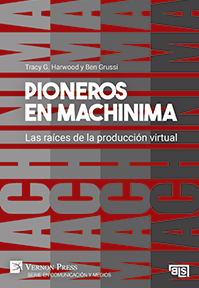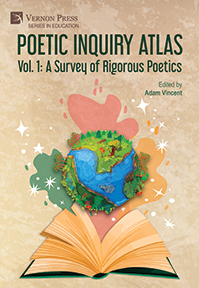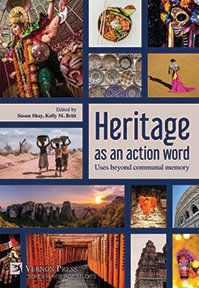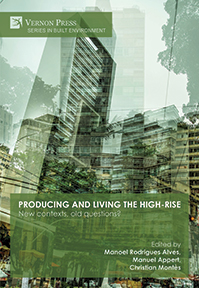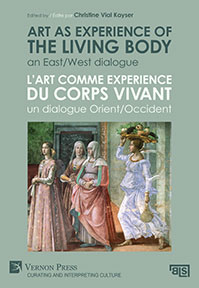Search
Browse
by Publication status
by Subject
Anthropology (26) Art (124) Business and Finance (26) Cognitive Science and Psychology (54) Communication and Journalism (45) Economics (62) Education (66) History (149) Human Geography (22) Interdisciplinary (42) Language and Linguistics (129) Law (16) Music Studies (18) Philosophy (157) Political Science and International Relations (103) Sociology (304) Statistics and Quantitative Methods (20)by Series
Series in Literary Studies (65) Series in Philosophy (59) Series in Education (51) Series in Sociology (42) Series in Politics (32) Series in World History (32) Bridging Languages and Scholarship (31) Series in Language and Linguistics (25) Cognitive Science and Psychology (20) Series in American History (20) Series in Philosophy of Religion (20) Series in Art (19) Critical Perspectives on Social Science (16) Series in Cinema and Culture (16) Curating and Interpreting Culture (15) Series in Critical Media Studies (14) Series on the History of Art (14) Series in Anthropology (13) Series in Business and Finance (13) Economics (13) Series in Music (12) Series in Communication (9) Series in Performing Arts (9) Philosophy of Personalism (8) Series in Law (8) Series in Economic Methodology (7) Series on Climate Change and Society (7) Women's Studies (7) Classics in Economics (6) Series in Economic Development (6) Philosophy of Forgiveness (5) Series in Built Environment (5) Series in Economic History (5) Series in Philosophy of Science (4) Series in Social Equality and Justice (4) Series on the History of Science (4) Serie En Estudios Literarios (3) Serie en Sociología (3) Series in Contemporary History (3) Series in Creative Writing Studies (3) Series in Design (3) The Interdisciplinary Built Environment (3) Serie en Comunicación y Medios (2) Serie en Historia (2) Series in Heritage Studies (2) Series in Innovation Studies (2) Series in Philosophy of Race (2) Serie en Ciencias Políticas (1) Serie en Entorno Construido (1) Serie en Estudios Culturales (1) Serie en Filosofía (1) Serie en Filosofía de la Ciencia (1) Serie en Música (1) Series in Classical Studies (1) Series in Economics of Technological Change (1) Series in Urban Studies (1)by Language
English Spanishby Author
Browsing with filters

Pioneros en Machinima: Las raíces de la producción virtual
Tracy Gaynor Harwood, De Montfort University
and Ben Grussi
Availability: Available 4 weeks
271pp. ¦ $63 £48 €54
Este importante nuevo trabajo se centra en los pioneros en machinima, considerados las raíces e inicios de la producción virtual. Los impactos de machinima son identificados por la comunidad, complementados por la investigación y por la experiencia de Harwood y Grussi durante un período de 25 años: desde juegos, cine y realización cinematográfica hasta la práctica de las artes digitales, desarrollos de tecnologías creativas e investigaciones y teorías relacionadas. Machinima es la primera práctica cultural digital que surgió de Internet y se convirtió en un género creativo convencional. Su última transformación es evidente a través de la creciente convergencia de juegos y películas, donde la producción virtual a tiempo real como práctica creativa profesional está dando como resultado nuevas formas de experiencias interactivas generadas por máquinas. Utilizando las obras machinima (del inglés 'machine' que significa máquina y 'cinema' que significa cine) de mayor importancia cultural como lentes para rastrear su historia e impactos, 'Pioneros en Machinima: Las raíces de la producción virtual' ofrece profundos testimonios de cineastas y otras personas involucradas en su surgimiento. La extensa referencia a materiales originales y entrevistas actualiza la historia de sus impactos a través de las reflexiones críticas de los primeros pioneros. Este libro será de interés para los investigadores y profesionales de machinima, junto con la cultura de los juegos, los teóricos de los medios, los estudiantes de estudios cinematográficos y de juegos, los artistas digitales y aquellos interesados en cómo las tecnologías creativas han influido en las comunidades de práctica a lo largo del tiempo.
Poetic Inquiry Atlas Vol. 1: A Survey of Rigorous Poetics
Edited by
Adam Vincent, Capilano University; The University of British Columbia, Canada
Availability: In stock
324pp. ¦ $108 £86 €101
This edited volume illustrates various definitions and uses of poetry in research and scholarship, both across disciplines and across the world. The collection offers a worldview of the capacity of poetic inquiry to enhance research and scholarship by showcasing rigorous poetics (which [re]present epistemology and aesthetics as synergistic) in action. Each chapter is intended to highlight diverse perspectives and uses of poetic inquiry, thereby highlighting commonalities and differences in praxis, that include: - Critical discussion around poetry and its uses in each poet-scholar’s diverse practices (e.g., research, writing, personal development, healthcare, mental health, ecology and/or scholarship). - An example of poetry that showcases their approach(es) in action. - Insights into the crafting of their poetry (i.e., what choices were made? why were specific choices made?) - An exploration of how their poetic work links to the vast rhizomatic array of poetic inquiry. This volume is well-suited for new scholars, looking for ways to integrate poetry into their praxis, and experienced scholars who wish to further their understanding of the capaciousness of poetic inquiry as a valuable method, methodology, tool and/or approach. It also holds insights for those interested in the power of poetry as it relates to mental health, health care, ecology, teaching, qualitative research and identity work.
Heritage as an action word: Uses beyond communal memory
Edited by
Susan Shay, Heritage Research Centre, University of Cambridge
and Kelly M. Britt, Brooklyn College and The Graduate Center, City University of New York, United States
Availability: In stock
242pp. ¦ $104 £83 €97
There is no limit to what constitutes heritage. By definition, heritage is the use of the past for present purposes. Yet, to any given group or population, heritage can be a multitude of things and can serve a variety of purposes. Based on shared memory, heritage can be tangible or intangible, boundless in variety and scope: it can be, for example, objects, landscapes, food or clothing, music or dance, sites or statues, monuments or buildings. Importantly, however, heritage also has many and varied uses and powers. It can be used to control, to unite, to engage, and to empower people, communities, and nations. In this interdisciplinary volume, authors from around the world explore how different communities, nations, and groups intentionally and creatively use heritage, both tangible and intangible, in a wide variety of ways to positively address social and environmental issues. Significantly, these studies demonstrate how heritage can be an exceptionally valuable tool for political, economic, and social change. Insightful studies are presented pertaining to heritage as social memory, including the nationalistic political use of heritage, heritage as resistance to political powers, traditional knowledge as environmental science, heritage for legal and community action, heritage for building peace, heritage for Indigenous and minority empowerment, and heritage for exploring the past through phenomenological methods. The goal of this volume is to move beyond seeing heritage as only social memory, a mere interpretation of static past events, people or places, and instead explores critically the variety of ways heritage is engaged in the present and can be in the future.
Producing and living the high-rise: New contexts, old questions?
Edited by
Manoel Rodrigues Alves, Universidade de São Paulo, Brazil et al.
Availability: In stock
502pp. ¦ $115 £92 €107
The purpose of the book is to assess the process of urban verticalization in different contexts through time, to provide insight into the relationships between highrise design and the way inhabitants negotiate them in their everyday lives, to assess how planners, politicians, and designers negotiate residential highrises in the strategies they develop for building the city and to introduce urban narratives and cartographies. Verticalization, although not new, currently takes place in a very different context than post-1945. Today, highrise residential buildings are more than architectural solutions: they are commodities in a global market where capital flows are fixed by developers and municipalities. Our exploration of residential verticalization is anchored in case studies, revealing different types of local-global negotiations in the design of the city, and has been framed by three interrelated dynamics: first, the complex relationships within the financialization of real estate markets, revealing differences in the types of local-global negotiations in the construction of the neo-liberal city; secondly, the most developed, anchors residential verticalization in the processes of socio-spatial differentiation within cities (mostly identified as gentrification associated to processes of urban renewal and densification; the third, related to readings and interpretations of the urban landscape and social, spatial practices and its iconographic and cartographic representations. This book is of interest to academics, students, planners, architects, and urban studies professionals. It shows that the chosen research object is an increasingly relevant angle of analysis of the contemporary city. It also provides a better knowledge of the processes of residential verticalization, their impact on the privatization of the urban space, and on urban segregation or fragmentation.
Art as experience of the living body / L’art comme experience du corps vivant
An East/West dialogue / Un dialogue Orient/Occident
Edited by
Christine Vial Kayser, Héritages UMR9022 (CNRS, CY, Ministère de la culture), France
Availability: In stock
794pp. ¦ $111 £92 €102
This book analyses the dynamic relationship between art and subjective consciousness, following a phenomenological, pragmatist and enactive approach. It brings out a new approach to the role of the body in art, not as a speculative object or symbolic material but as the living source of the imaginary. It contains theoretical contributions and case studies taken from various artistic practices (visual art, theatre, literature and music), Western and Eastern, the latter concerning China, India and Japan. These contributions allow us to nourish the debate on embodied cognition and aesthetics, using theory–philosophy, art history, neuroscience–and the authors’ personal experience as artists or spectators. According to the Husserlian method of “reduction” and pragmatist introspection, they postulate that listening to bodily sensations–cramps, heartbeats, impulsive movements, eye orientation–can unravel the thread of subconscious experience, both active and affective, that emerge in the encounter between a subject and an artwork, an encounter which, following John Dewey, we deem to be a case study for life in general. Ce livre analyse la relation dynamique entre l’art et la conscience subjective, selon une approche phénoménologique, pragmatiste et enactive. Il vise à faire émerger une nouvelle approche du rôle du corps dans l’art, non pas comme objet spéculatif ou matériau symbolique, mais comme source vivante de l’imaginaire. Les contributions théoriques et les études de cas sont prises à diverses pratiques artistiques (arts visuels, théâtre, littérature et musique), occidentales et orientales, ces dernières concernant la Chine, l’Inde et le Japon. Selon la méthode husserlienne de « réduction », en écho à l’introspection pragmatiste, les textes témoignent que l’écoute des sensations corporelles – crampes, battements de cœur, mouvements pulsionnels, orientation des yeux – mises en jeu par l’œuvre, permet de dénouer le fil de l’expérience inconsciente, à la fois kinesthésique et affective, qui émerge dans la rencontre entre un sujet et une œuvre d’art, une rencontre comprise, à la manière de Dewey, comme un cas d’école de la vie en général.

